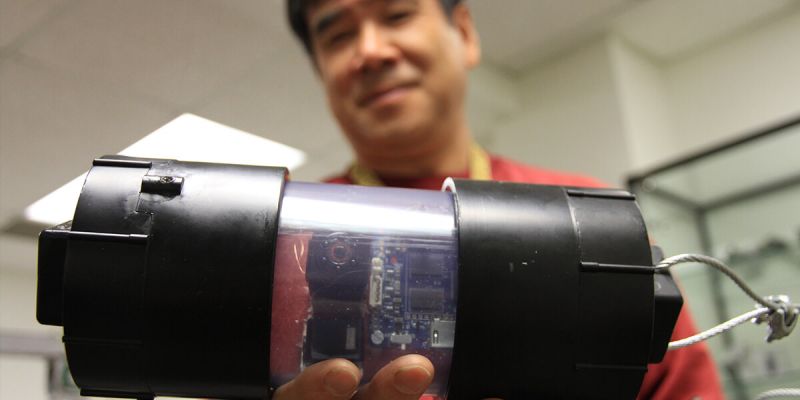“PipeFish” Robot Patrols City Pipes to Detect Underground Water Leaks
Published on by Water Network Research, Official research team of The Water Network in Technology
Researchers at USC’s Information Sciences Institute (ISI) are developing an autonomous robot that could quickly and inexpensively detect damage in water pipes—even those buried meters below the ground.
Created by Wei-Min Shen, director of ISI’s Polymorphic Robotics Lab and research associate professor of computer science in USC’s Viterbi School of Engineering, the robot is inserted into the water system through existing fire hydrants.
The device captures real-time video, using sensors and navigation technology to collect data and log its position as it goes.

WEI-MIN SHEN, DIRECTOR OF ISI’S POLYMORPHIC ROBOTICS LAB, HOLDS PIPEFISH, AN AUTONOMOUS ROBOT THAT DETECTS DAMAGE IN UNDERGROUND WATER PIPES USING AN ONBOARD CAMERA, SENSORS, AND NAVIGATION TECHNOLOGY. PHOTO/CAITLIN DAWSON. VIA USC
Shen has been working with the Los Angeles Department of Water and Power (LADWP) to develop and test the robot, called Pipefish, for the past year. Support for the project comes from real estate magnate and philanthropist Michael Keston who, with his wife Linda, created ISI’s first endowed directorship position in 2015.
“This could be a game changer,” says Shen. “Instead of excavating and replacing every pipe, which is a huge expense, PipeFish can narrow in on specific problems to enable repair before serious damage occurs.”
A fish-eye view
Once the robot is retrieved, the data can be uploaded and analyzed to detect warning signs of defects inside the pipe. Using this system, there is no need to shut off the water supply. Shen and his team are currently carrying out “dry tests” in pipes at the LADWP’s Sylmar West Facility in the San Fernando Valley region. In early 2018, they plan to add water to the system and test the device in different pipes of various diameters under the city.
“The ability to perform accurate and efficient condition assessments on buried pipes will tremendously help Los Angeles and other cities with aging infrastructures,” says Ray Hardjadinata, associate engineer with the LADWP Asset Management Group working with Shen and his team.
“We are pleased to partner with research institutions and universities such as the USC Information Sciences Institute to develop robots that can help us work more efficiently.”
Read full article: USC Viterbi
Media
Taxonomy
- Water Supply
- Leakage Detection
- Water Supply
- Leakage
- Infrastructure
- Leakage Reduction
- Urban Water Infrastructure
- Infrastructure Management
- Pipeline
- Pipeline Rehabilitation
- green infrastructure
- Pipes and Pipelines
- Pipes and Pipelines